Look closely at nature. Every species is a masterpiece, exquisitely adapted to the particular environment in which it has survived.
Edward O. Wilson
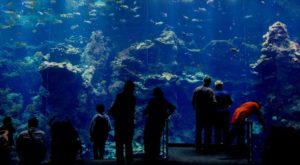
Johannes Kepler (1571-1630), who gave us our understanding of the laws governing planetary motions, had this to say about the stunning variety of life on our planet. The diversity of the phenomena of nature is so great . . . that the human mind shall never be lacking in fresh nourishment. I couldn’t agree more. It has been my good fortune to spend countless hours in pursuit of this nourishment.
I’ve done so for over sixty years. And I admit that sometimes I find myself guilty of taking Earth’s rich biodiversity for granted. At times I need an event, a sighting, an experience, to bring me back to an awareness of just how amazing and varied the living world which surrounds us really is.
We humans must be careful. Our passion for the time-consuming overuse of social media, our need to be constantly entertained, and the anxiety-producing pressures of the modern world can be distracting. They can easily cause us to forget that we live in a world of infinite beauty, spectacular variety, and abundant mystery.
The famous naturalist and explorer Alfred Wallace (1823-1913) once questioned whether we humans were really fulfilling the purpose of our existence when so many of the wonders and beauties of the creation remain unnoticed around us. I’ve wondered that myself but, of course, as a biologist I am biased. But I recently had a realization. It was the sudden recognition that, of late, I had lazily been neglecting the astounding variety, abundance, and fascination of the tens of thousands of species of animals without a backbone (the invertebrates) which live in our oceans.
Such animals outnumber the vertebrates by something like 24:1. Is it their size which causes me to often overlook them? Granted, some, like the giant squid, are huge (> 60 ft.). But, on average they are only around two inches in length. Or perhaps it is a combination of small size, secretive habits, and strange habitats which cause me to forget what a diverse and interesting group such animals represent. Maybe I’m just prejudiced by my long infatuation with reptiles, birds, and mammals? Whatever the reason, one should be impressed by the fact that about 99% of all the animals in the world are invertebrates. The insects alone make up 80% of all the world’s animal species. Talk about unappreciated!
A few months ago, I had the opportunity to visit one of the world’s best marine museums, the Monterey Bay Aquarium. Here I was prompted to remember that there are indeed wonders and beauties of the creation to be found. Upon this, our little island in the cosmic sea, reside a host of creatures mostly unseen, easily overlooked, and mostly unacknowledged. These are the animals without backbones which dwell in the world’s oceans.
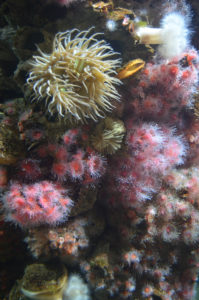 Gazing into one of the aquarium tanks, I considered the strangeness of the sea anemones. In these photos, there are at least five different species. In the world’s oceans, there are over 1,000 different kinds. For a
Gazing into one of the aquarium tanks, I considered the strangeness of the sea anemones. In these photos, there are at least five different species. In the world’s oceans, there are over 1,000 different kinds. For a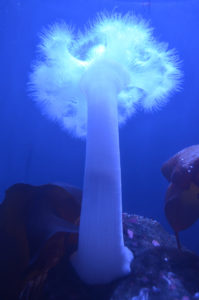 mobile species like us, how odd it seems to be non-motile, stuck in one place. Equally curious would be having a body with no head, no back, no front, no rear. Sea anemones have radial symmetry. I wonder what that would feel like?
mobile species like us, how odd it seems to be non-motile, stuck in one place. Equally curious would be having a body with no head, no back, no front, no rear. Sea anemones have radial symmetry. I wonder what that would feel like?
Their central mouth is surrounded by a cluster of tentacles. These bear stinging cells which paralyze their prey and afterwards draw the victim into a hollow body where digestion occurs. No stomach, no intestine; anything inedible is ejected via the mouth. But still, they are lovely. In their varying colors, swaying with the ocean currents, they do bear a resemblance to flowers. Thus, the appellation: anemone.
 The clown fishes which brazenly swim among the anemone’s tentacles represent an interesting ecological relationship known as mutualism. In this type of symbiosis, both animals receive benefit from their association. The fishes, while shielded from being stung by a thick coating of mucus, receive protection from predators. The anemone benefits from the clown fishes’ wastes which fertilize the algae growing symbiotically inside the anemones (a whole other fascinating story of mutualism). Clown fishes may also remove parasites from the anemone or lure prey within reach of the anemone’s tentacles.
The clown fishes which brazenly swim among the anemone’s tentacles represent an interesting ecological relationship known as mutualism. In this type of symbiosis, both animals receive benefit from their association. The fishes, while shielded from being stung by a thick coating of mucus, receive protection from predators. The anemone benefits from the clown fishes’ wastes which fertilize the algae growing symbiotically inside the anemones (a whole other fascinating story of mutualism). Clown fishes may also remove parasites from the anemone or lure prey within reach of the anemone’s tentacles.
Anemones are often found attached to a foundation of coral. A whole world  of life can be centered upon a coral reef. Corals (>6000 species) are animals too. Their bodies resemble tiny sea anemones but are noted for their ability to secrete a
of life can be centered upon a coral reef. Corals (>6000 species) are animals too. Their bodies resemble tiny sea anemones but are noted for their ability to secrete a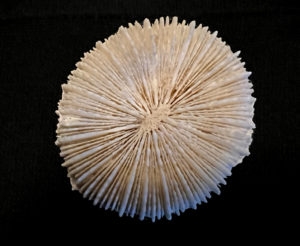 protective, limestone, exoskeleton. Some, such as brain corals and the mushroom coral are solitary and live in their own small, isolated colonies.
protective, limestone, exoskeleton. Some, such as brain corals and the mushroom coral are solitary and live in their own small, isolated colonies.
Others join forces, and over the millennia grow into the massive bulwarks that we recognize as coral reefs. These, with their many cavities, ledges, and fissures provide housing for a multitude of other animals.
Aside from the spectacular fish species that inhabit coral reefs, there is a plethora of invertebrate animals associated with them, or swimming in the seas around them. There are sea squirts, spoon worms, diatoms, comb jellies, polychaeta worms, brachiopods, and bryozoans. Joining these are siphonophores, isopods, and amphipods. Added to the biodiverse mix are the various kinds of phytoplankton and zooplankton.
As I encountered the names of these groups, one after another, it occurred to me that I knew very little about the lifestyles, ecological relationships, or environmental importance of these groups. It was a humbling reminder that even years of specialized study leaves one to savor only a tiny wedge from the immense pie that is life on Earth.
Closely related to the anemones and corals are the jellyfishes. These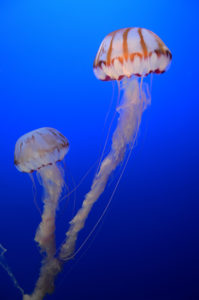 creatures (>2000 species) have the same radial symmetry, simplicity of body form, and lack of organ systems. But they can move. The mesmerizing pulsating of their “bells” forces out the water within, a practical application of Newton’s Third Law of Motion. Their tentacles also bear stinging nematocyst cells. Some, like the infamous box jellyfish, inject toxins capable of killing a human.
creatures (>2000 species) have the same radial symmetry, simplicity of body form, and lack of organ systems. But they can move. The mesmerizing pulsating of their “bells” forces out the water within, a practical application of Newton’s Third Law of Motion. Their tentacles also bear stinging nematocyst cells. Some, like the infamous box jellyfish, inject toxins capable of killing a human.
Others are less toxic. I once inadvertently swam into the remnants of a jellyfish that had been pounded to smithereens by the surf. I detected the sudden presence of its disembodied stinging cells as numerous, widely dispersed, tiny, bee-like irritations over my shoulders and chest.
Jellyfishes have been swimming the world’s oceans for an exceedingly long time. Their fossil history goes back at least 600,000,000 years. Some are tiny (<1mm), some are huge (> 5 ft. in diameter), all deserve admiration for their skill in being long-term voyagers in the sea of life.
If you have beachcombed for shells, you have likely recognized that there is a huge variety of clams in the world. But that’s just one group (bivalves) within a larger group (mollusks). There are around 50,000 species of mollusks in the oceans. Aside from clams, there are thousands of species of gastropods (snails, conchs, sea slugs, abalones, nudibranchs, sea hares), tooth shells, and chitons that live in the ocean. The mollusks represent yet one more group that is tremendously abundant, highly varied in form, and yet often entirely forgotten by most of us.
And let’s not forget that among the mollusks we also find the cuttlefishes, octopuses, and squids. Over 1,000 different species of these strange creatures swim the oceans of the world.
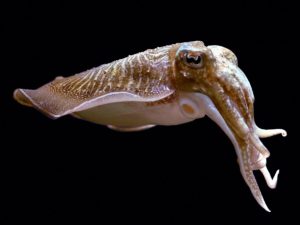
This is a group of animals that particularly fascinates me. This allure began when I was a boy. In 1954 Walt Disney produced a movie based upon the Jules Verne book, Twenty Thousand Leagues Under the Sea. What a tale of adventure that was for an eight-year-old boy! One of the scenes which enthralled me, has stayed with the most, was the attack upon the submarine Nautilus by a giant squid. I can’t recall being previously aware that such a creature really existed.
Of course, the movie did take some liberties with the size and abilities of the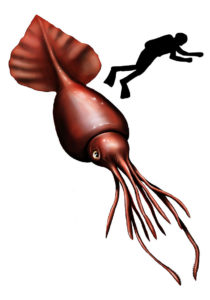 giant squid. Nevertheless, I learned that this animal (of which there are several species) was real and is, in fact, considered the largest invertebrate animal in the world. The giant squid can be over 40 ft. long (mostly tentacle length). The closely related colossal squid is bulkier with a record weight of over half a ton.
giant squid. Nevertheless, I learned that this animal (of which there are several species) was real and is, in fact, considered the largest invertebrate animal in the world. The giant squid can be over 40 ft. long (mostly tentacle length). The closely related colossal squid is bulkier with a record weight of over half a ton.
Adult giant squids are abyssal creatures, meaning they live at great depths in the ocean (> 1000 ft.). As a result, they are seldom encountered, and very little is known about their habits. Scientists do know that sperm whales prey upon giant squids. The horny beaks of the squid have been found in the whale’s stomachs. Sperm whales are known to dive over 5,000 ft. beneath the surface of the ocean. Quite possibly, the giant squids go down that far too.
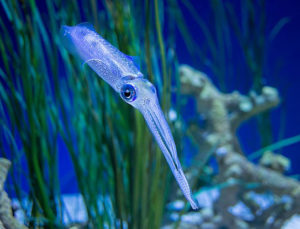
As an undergrad, my comparative anatomy professor related a story he had heard about a sperm whale taken by whalers. It seems the whale had a giant squid sucker scar on its skin that was a foot in diameter. There are two rows of suckers on each squid tentacle. Thus, each tentacle would have had to have been close to three feet in diameter. How huge would such a squid have to have been? Could a squid of such monstrous size be lurking in the ocean depths? Or did the sucker scar merely stretch, like a distorted tattoo, as the whale grew? The mystery remains.
 The octopuses also intrigue me greatly. Zoologists consider them to be the most intelligent of all invertebrates. Cuttlefishes and squids also have large brain to body size ratios, but octopuses are the star pupils. Their brains are said to contain as many neurons as a mouse’s brain.
The octopuses also intrigue me greatly. Zoologists consider them to be the most intelligent of all invertebrates. Cuttlefishes and squids also have large brain to body size ratios, but octopuses are the star pupils. Their brains are said to contain as many neurons as a mouse’s brain.
I once saw a video depicting the interaction of two octopuses. One had learned how to remove the plug from a submerged bottle, crawl inside, and eat a shrimp contained within the bottle. A second octopus had tried but not yet mastered the trick needed to get inside the bottle.
The two were placed in an aquarium but separated by a glass partition. The well-versed octopus was presented another bottle and promptly opened it and secured the shrimp. Now the second, less adept octopus was again presented a stoppered bottle containing a shrimp. After having observed its neighbor use the required technique it, without hesitation, pulled the plug, slithered into the bottle, and ate the shrimp. This action appeared to be a clear case of learning behavior, a most complex type of neural activity. Here is a similar act of intelligence: Octopus Opening a Jar to Get Dinner! – YouTube
I must admit that, after learning of the extreme intelligence of octopuses and watching Netflix’s My Octopus Teacher, I doubt I will ever be able to look at them as a potential food item again.
I hope this brief tour of the world of marine invertebrates has given you greater appreciation for the abundant and fascinating biodiversity of this often-ignored group. Their body forms, their ways of life, the many mysteries regarding their ecology, offer endless opportunities for us to be amazed. They remind us that we live on a planet of immense spectacle and allure. By considering them, we are encouraged to follow Wallace’s prompt and perhaps do a better job of noticing the wonders and beauties of the creation. If only we take the time to do so.
____________________________________
Photo Credits:
Cuttlefish by Hans Hillewaert at commons.wikimedia.org (distributed by a CC BY-SA 4.0 license) Octopus by Revital Salomon at commons.wikimedia.org (distributed by a CC BY-SA 4.0 license) Squid by Rhododendrites at commons.wikimedia.org (distributed by a CC BY-SA 4.0 license) Squid/human size comparison by Citron at commons.wikimedia.org (distributed by CC-BY-SA-3.0 license) All other images by the author.
